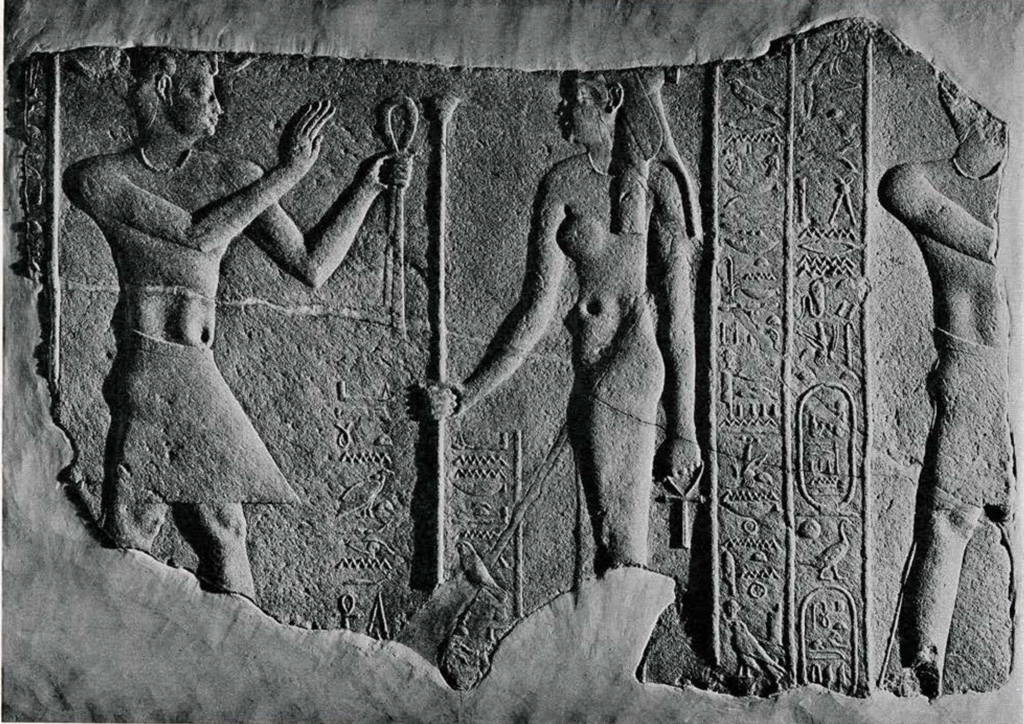THE portion of granite bas-relief on exhibition on the east wall of the Lower Hall of the Egyptian wing shows Ptolemy Philadelphus presenting a band of linen to the goddess Isis. This king reigned from 285 to 246 B.C. It was in c. 250-B.C. that a colony of Greek soldiers founded the Egyptian Philadelphia in the Faiyûm. The power of Egypt abroad was at this time at its zenith and the country was on excellent terms of friendship with Rome.

Maximum Dimensions: H. 1.2 m; W. 1.7 8 m
Museum Object Number: E15728
Image Number: 31315
This relief was acquired by purchase from D. G. Kelekian in 1926 and is said to have come from Samannud, in the Delta on the Damietta arm of the Nile, which is the site of the ancient Sebennytos, the birthplace of Manetho, who wrote a history of Egypt during Ptolemy II’s reign. Publication of blocks from the ruins of the Temple of Isis at Bahbit el-Higara in the vicinity, which bear reliefs similar to ours leads one to believe that our relief came from this temple, which was built by Nectanebis II, 358-341 B.C. and Ptolemy II.1 The blocks in these ruins are, like ours, of granite, which must have been transported a great distance, for there are no granite quarries in the vicinity.
The goddess holds in the right hand a sceptre with a head representing the head of a stem of papyrus, and in the left the symbol of life. The crowns are missing but from the other reliefs published we may conjecture that the King wore the Double Crown of Upper and Lower Egypt, and the goddess a vulture cap, (a part of which is showing), with the head of the vulture protruding from the forehead, surmounted by a cluster of uraeii upon which was set the sun disk within cow’s horns.
The inscription, although not complete, may be translated, with one or two restorations, thus:
First column (beginning-from left): “Giving a band of linen to his mother that he may be given life.”
Second column: “I give to thee the accession of Horus upon his throne forever.”
Third column: ” . . . We increase thy might in all lands, that thou mayest rule (as King of Upper Egypt) Egypt on the four (sides) of the land (i.e. the whole land); that thou mayest rule (as King of Lower Egypt) that which the sun encircles, upon the Horus throne of the living.”
Fourth column: “. . . clothing his mistress in the dress of Ernutet: the King of Upper and Lower Egypt, Weserkarē-merenamūn; the son of Re, Ptolemy . . . “
Thus we perceive that we have here a part of a relief which depicts the religious ceremonies in which the King dedicates offerings to the gods. Such scenes, together with processions at religious festivals and scenes from the King’s campaigns, decorated the walls and columns of temples. Upon other blocks found on this site, the King is shown presenting such offerings as wine, incense, oil, food, and clothing. In our relief it is probably a piece of fine white linen. The Egyptians took great pride in their linen and used all their skill in preparing the finest and whitest, which was worn by men of exalted rank. It was to them the highest conception of personal cleanliness and purity, and as such what could be more appropriate to offer to the gods?
The name Ernutet may bear explanation. This was the goddess of harvest and divine nurse. She is depicted sometimes as a woman with the head of a uraeus serpent, or as a large uraeus serpent wearing the solar disk and cow’s horns of Hathor upon its head.
The nature of the art displayed in this relief is typical of the period and may be seen in the temples of the time, such as those at Edfu, Kon Ombo, Medinet Habu, and particularly in the Temple of Hathor at Dendereh. It displays a roundness and plumpness of form which may be called almost swollen. While remaining essentially Egyptian it is thought by some Egyptologists to be greatly influenced by Greek art, which had attained its highest perfection in the 4th century B.C. This is also the feeling of the writer, but there are others who would see no outside influence and believe this art entirely Egyptian despite the establishment of the Greeks in the Nile valley for centuries. Certain it is that this art differs from the beautiful works attained by the Egyptian during the high points of development in the Old and Middle Kingdoms.
Art similar to this in the Museum may be seen on the three slabs from a temple built by Ptolemy Soter about 300 B.C., on the southwest wall of the Upper Egyptian wing. For undisputed Greek influence compare the statue of an unknown man from Koptos in the southern end of the same wing. 2
P. M.
1 Naville, Détails relevés dans les ruines de quelques temples Égyptiens. Paris, 1930. Pls. 1-17.
Roeder. Zeitschrift für Aegyptische Sprache, 46 p. 62-73.
Edgar & Roeder, Recueil de Travaux 35. p. 89-116.↪
2 American Journal of Archaeology, vol. 10, pp. 347 ff. Petrie-Koptos, p. 22.↪

